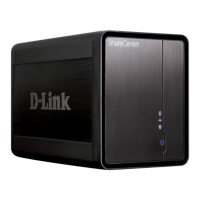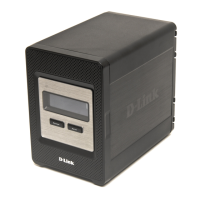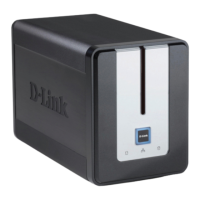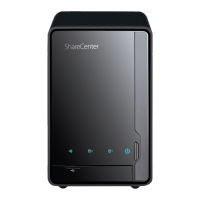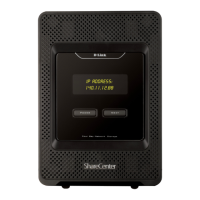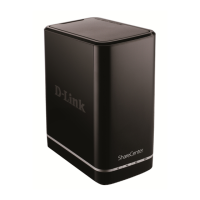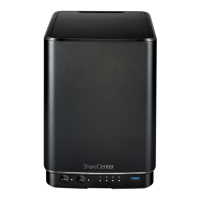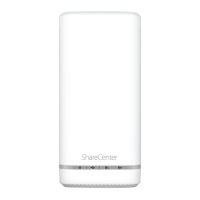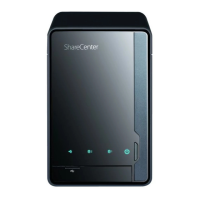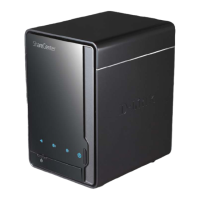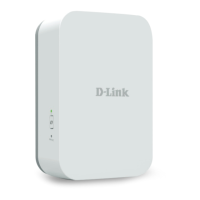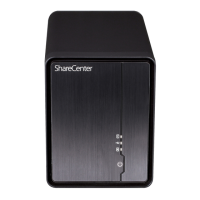
Do you have a question about the D-Link ShareCenter Shadow DNS-325 and is the answer not in the manual?
| Device Type | NAS server |
|---|---|
| Drive Bays | 2 |
| RAM | 128 MB |
| Connectivity | Gigabit Ethernet |
| Operating Temperature | 0°C to 40°C |
| Supported Drive Types | SATA |
| USB Ports | 2 x USB 2.0 |
| RAID Support | RAID 0, RAID 1, JBOD |
| Max Internal Capacity | 6 TB (3 TB per drive) |
| Features | DLNA Certified, iTunes Server, FTP Server |
| Compliant Standards | DLNA |
| Remote Management Protocol | HTTP, FTP |
| Operating Humidity | 5% to 95% non-condensing |
| Noise Level | 25 dB |
Provides an overview of the ShareCenter's capabilities and features.
Lists all the items included in the ShareCenter box.
Details the minimum system specifications needed to use the ShareCenter.
Describes the components and indicators on the front of the ShareCenter.
Details the ports and connectors located on the rear of the ShareCenter.
Instructions for using the software CD to install utilities and wizards.
Explains how to use the utility to locate and configure the ShareCenter on the network.
Guides through the initial setup process for the ShareCenter.
Step-by-step instructions for opening the device and installing hard drives.
Details on connecting to the network and initial device setup.
Explains how to power on the device and select it for configuration.
Instructions for setting or changing the administrator password for the ShareCenter.
Configuration of network settings like IP address and workgroup.
Setting up Dynamic DNS for remote access via a URL.
Creating a DDNS account and configuring system time and timezone.
Configuring email alerts and viewing volume information.
Setting up RAID and mapping network drives.
Reviewing settings and formatting the hard drives.
Confirmation of formatting and installing optional add-on packages.
Final confirmation of the setup wizard completion.
Accessing the ShareCenter's web-based management interface.
Overview of the main interface sections: My Favorites, Applications, and Management.
Accessing various management functions through icons.
Re-running the setup wizard via the web interface for basic configuration.
Setting or changing the administrator password through the web UI.
Selecting the correct time zone for the ShareCenter.
Configuring the network connection type (DHCP or Static IP).
Setting the workgroup, name, and description for the ShareCenter.
Setting up email alerts for system notifications.
Options for configuring RAID types and formatting hard drives.
A wizard to guide through setting RAID type, formatting, and volume creation.
Choosing the desired RAID format like Standard, JBOD, RAID 0, or RAID 1.
Configuring auto-rebuild for RAID 1 drives upon replacement.
Determining the size of RAID volumes and handling remaining space.
Reviewing the configured volume settings before formatting.
Progress indicator for the hard drive formatting process.
Final confirmation of the hard drive setup and configuration.
Creating scheduled S.M.A.R.T. tests for regular monitoring.
Viewing and managing created S.M.A.R.T. test schedules.
Creating and managing user and group accounts for access control.
Step-by-step guide to creating new user accounts.
Assigning a user account to an existing group.
Configuring network access rights for shared folders.
Selecting application privileges like FTP or WebDAV for users.
Configuring WebDAV access rights for specific volumes.
Setting storage quotas for users to limit allocated space.
Confirming the new user account creation and its settings.
Assigning user accounts to the newly created group.
Configuring network access rights for the group.
Selecting protocol privileges like FTP or WebDAV for groups.
Setting storage quotas for groups.
Confirming the new group creation and its settings.
Configuring shared folders, rights, and mounting ISO files.
Wizard for creating new network shares and defining access.
Defining who can access shared folders (all users or specific users/groups).
Setting specific access levels (Read Only, Read Write, Deny Access) for shares.
Assigning access rights to individual users for network shares.
Assigning access rights to groups for network shares.
Configuring share settings like oplocks and network protocol support.
Assigning protocol privileges (FTP, NFS, WebDAV) for share access.
Configuring FTP access settings for shares, including anonymous access.
Configuring NFS access parameters like host, root squash, and write permissions.
Configuring WebDAV access parameters for shares.
Summarizing and completing the network share creation.
Assigning access privileges to ISO Mount shares.
Assigning protocol privileges for ISO Mount share access.
Summarizing and completing the ISO mount share creation.
Configuring network settings like IP address, subnet mask, and gateway.
Adjusting network link speed and enabling/disabling LLTD.
Configuring the FTP server settings like max users, idle time, and ports.
Enabling and configuring the UPnP AV Server for media streaming.
Setting up the iTunes Server to share music and videos.
Installing and managing additional applications to extend ShareCenter functionality.
Enabling the Apple Filing Service for Mac OS X compatibility.
Enabling the Network File System (NFS) service for multi-platform access.
Installing and selecting language packs for the ShareCenter interface.
Setting the system time, date, and timezone, or using NTP server.
Setting the workgroup, name, and description for the ShareCenter.
Restarting, restoring defaults, or shutting down the ShareCenter.
Saving and loading ShareCenter configuration settings.
Setting idle timeout for web UI access.
Configuring automatic shutdown based on system temperature.
Enabling or disabling hard drive hibernation.
Enabling automatic device restart after power failure.
Adjusting the speed of the cooling fan.
Scheduling automatic power-off times for the ShareCenter.
Adding details for an SMS service provider for alerts.
Selecting specific events to trigger email or SMS alerts.
Viewing static and dynamic system information like network settings and uptime.
Displaying local network settings of the ShareCenter.
Showing workgroup, name, description, temperature, and packet counts.
Displaying hard drive status, disk mode, used, and remaining space.
Scheduling file and folder backups from FTP or web servers.
Specifying download destination, renaming, language, and timing.
Configuring recurring and incremental backups for scheduled tasks.
Activating the remote backup server functionality.
Selecting the type of remote backup service (NAS to NAS, NAS to Linux).
Configuring local task name, folder path, and remote IP/encryption.
Selecting the remote path and setting the schedule mode (Manual, Once, Scheduled).
Finalizing the remote backup job creation.
Selecting backup method (Internal, LAN) and providing login details.
Specifying destination, timing, and options for local backups.
Scheduling recurring and incremental local backups.
Enabling Time Machine compatibility for backups.
Changing the order of icons in the My Favorites tab.
Methods for adding icons to the My Favorites tab.
Removing icons from the My Favorites tab.
Explanation of RAID technology and its different levels.
Using the D-Link Storage Utility to map network drives.
Displaying available volumes and selecting drive letters for mapping.
How to access mapped drives through My Computer.
Using the Windows Add Printer Wizard to connect to the ShareCenter printer.
Selecting and installing the correct printer driver.
